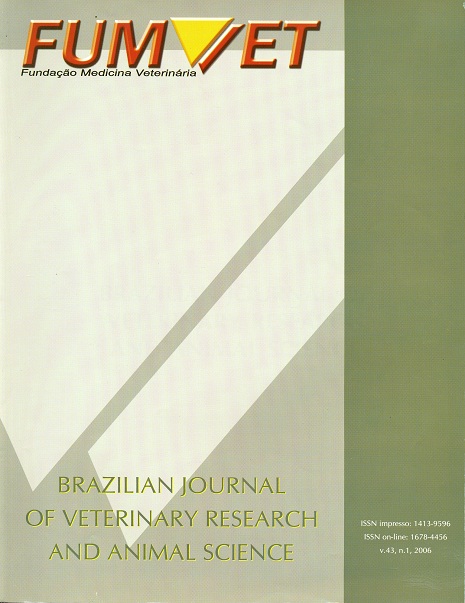Diagnosis of energy deficiency in cattle by ruminal metabolism tests
DOI:
https://doi.org/10.11606/issn.1678-4456.bjvras.2006.26515Keywords:
Cattle, Energy deficiency, Diagnosis, Ruminal metabolism, Ruminal testsAbstract
Ten yearling crossbred rumen-cannulated steers were randomly divided in two equal groups for studying some ruminal metabolism tests in cattle fed adequate or deficient diets on energy. The control group (C) was fed a diet to gain 900 g/BW/d, while to the very deficient group (VD) was given a diet with 30 % less than the maintenance level of dietary energy. On the 140th d ruminal fluid and urine samples were collected at the basal and in the 1st, 3rd, 6th, and 9th h after the morning feeding. The energy deficiency caused significant decrease in the ruminal levels of total volatile fatty acids (VFA), propionic and butyric acids, and ammonium, an increase in time of methilene blue reduction test (MBRT) and decrease in the gas production in the glucose fermentation test (GFT); the urinary allantoin excretion rate (UAER) was also lower. The deficiency caused an increased in the molar proportion of acetic acid. There was no diet effect on the ruminal fluid pH. There were high positive correlation between GFT and VFAs and ammonium, medium positive correlation between MBRT and VFAs, ammonium, GFT and UAER. All studied variables were able to detect changes in the ruminal metabolism in cattle fed energy deficient diet, but the rumen fluid pH. Nevertheless, as far as the feasibility is concerned the MBRT, followed by the GFT should be adopted to allow a rapid and sensible diagnosis of dietary energy deficiency.Downloads
Download data is not yet available.
Downloads
Published
2006-02-01
Issue
Section
UNDEFINIED
License
The journal content is authorized under the Creative Commons BY-NC-SA license (summary of the license: https://
How to Cite
1.
Soares PC, Maruta CA, Sucupira MCA, Mori CS, Kitamura SS, Antonelli AC, et al. Diagnosis of energy deficiency in cattle by ruminal metabolism tests. Braz. J. Vet. Res. Anim. Sci. [Internet]. 2006 Feb. 1 [cited 2026 Jan. 18];43(1):33-41. Available from: https://revistas.usp.br/bjvras/article/view/26515





